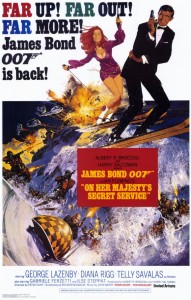The New Bond. 007 and Bride.
It’s challenging to talk about some movies- Gone with the Wind, Citizen Kane, and perhaps the entire James Bond franchise. Particularly the latter as Bond has so many die hard fans. For me, perhaps the best (or at least one of the best Bonds ever) of the lengthy series is 1969’s On Her Majesty’s Secret Service. OHMSS has always been a bit of a misnomer within the onscreen Bond canon, with nobody just quite sure where to put it.
Fans of the series will be aware of the films’ predeliction to, over time, border on the absurd, with each film upping the ante over its predecessor. Several time the franchise has chosen to reset itself in an attempt to ground itself a bit more inreality- the most recent reset being the introduction of Daniel Craig in Casino Royale, though this was also done on the introduction of Timothy Dalton and For Your Eyes Only during the Roger Moore years. Some would argue with the last citation, but oh well.
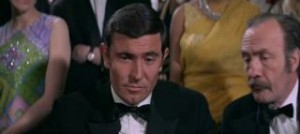 Perhaps the greatest reset of the series, however, was when George Lazenby, a relative unknown, stepped in for a disgruntled Sean Connery as 007 in 1969, after Connery refused to continue in the part after the Asian themed You Only Live Twice. Interesting to note that during the promotional blitz for You Only Live Twice most ever poster and marquis announced, “Sean Connery IS James Bond.” Such a close association with the character definitely made his successor’s role simply that much more difficult.
Perhaps the greatest reset of the series, however, was when George Lazenby, a relative unknown, stepped in for a disgruntled Sean Connery as 007 in 1969, after Connery refused to continue in the part after the Asian themed You Only Live Twice. Interesting to note that during the promotional blitz for You Only Live Twice most ever poster and marquis announced, “Sean Connery IS James Bond.” Such a close association with the character definitely made his successor’s role simply that much more difficult.
In response, the producers did reset the series, basing it more in the real world- omitting the numerous gadgets which over time creep into the storylines, including several bordering on ridiculous (for the time) in You Only Live Twice. In OHMSS the only gadget, if you will, is an electronic safecracking device which isn’t too far from reality. The outlandishness of gadgets reached a high (or low) point in Pierce Brosnan’s last outing as Bond, the lackluster Die Another Day. Remember the invisible car?
Other changes were made as well. On Her Majesty’s Secret Service is, to date, the only Bond film with the star’s name appearing below the title and the finished film doesn’t even have the required title song, although John Barry turns in perhaps is best of all Bond scores. Featured here is a driving theme including synthesizers and electrified instruments.
And, although at the time perhaps reviled, George Lazenby acquits himself mighty nicely here. No, he isn’t as brusque and hard as Connery. But neither is he the buffoon that Bond under Roger Moore became- for example, in Moore’s next to last Bond, Octopussy, Bond disguises himself as a clown. A clown!?!
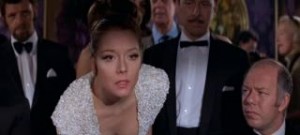 But none of that here in 1969 with George Lazenby and his leading lady Diana Rigg, who has the distinction of being the only actress to play Mrs. James Bond, as old James marries in this one. Lazenby, hampered perhaps only by at times ludicrous costuming, masters the screen with his performance, especially in the action scenes (of which there are plenty), some of which are better than those of Connery himself, often regaled as the toughest of all Bonds.
But none of that here in 1969 with George Lazenby and his leading lady Diana Rigg, who has the distinction of being the only actress to play Mrs. James Bond, as old James marries in this one. Lazenby, hampered perhaps only by at times ludicrous costuming, masters the screen with his performance, especially in the action scenes (of which there are plenty), some of which are better than those of Connery himself, often regaled as the toughest of all Bonds.
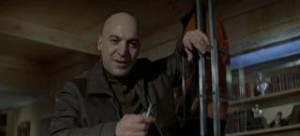 George Lazenby, who in all fact is closer to author Ian Fleming’s conception of Bond than Sean Connery, has presence which rivals Connery’s presence in the original [intlink id=”1303″ type=”post”]Dr. No[/intlink]. We have a bit of deception to open the film, with Bond’s face hidden for the first several shots during the drive to and ultimate fight on the beach. This suspense makes perhaps George Lazenby’s most iconic line more impressive. “This never happened to the other fella.”- in a clear allusion to Connery.
George Lazenby, who in all fact is closer to author Ian Fleming’s conception of Bond than Sean Connery, has presence which rivals Connery’s presence in the original [intlink id=”1303″ type=”post”]Dr. No[/intlink]. We have a bit of deception to open the film, with Bond’s face hidden for the first several shots during the drive to and ultimate fight on the beach. This suspense makes perhaps George Lazenby’s most iconic line more impressive. “This never happened to the other fella.”- in a clear allusion to Connery.
There are throughout the film nice allusions to the past, tying the picture in with its predecessors. As an example, Bond still throws his bowler in Moneypenny’s office, just like Connery’s Bond. We still have the fine supporting cast with folks like Bernard Lee, Desmond Llewelyn, and Lois Maxwell. Outside the normal characters we have Peter Hunt, the hard driven traditional second unit director, taking top directing honors. For the superstar criminal we have Telly Savalas as Ernst Stavro Blofeld.
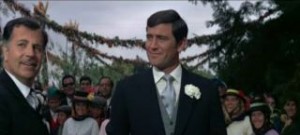 Peter Hunt delivers a fast paced film which, although lengthy in terms of run time, passes in mere moments. The plot moves well and realistically and, perhaps for the first time, Bond becomes a person- at least one infused with a bit of emotion. Not only does Bond marry, but the final scene is perhaps the most emotional in the history of the entire series.
Peter Hunt delivers a fast paced film which, although lengthy in terms of run time, passes in mere moments. The plot moves well and realistically and, perhaps for the first time, Bond becomes a person- at least one infused with a bit of emotion. Not only does Bond marry, but the final scene is perhaps the most emotional in the history of the entire series.
For the time especially, the action is breathtaking. For example, this is one of the few times you’ll see a fight on a bobsled track – while riding bobsleds! OHMSS also covers the required exotic (or at least foreign) locales with the spectacular Swiss landscape and especially Piz Gloria.
OHMSS isn’t perfect, but by far is the strongest of all Bond pictures. Diana Rigg is among the best, if not the best, Bond girl, as much as she really didn’t like the part. Yes, there have been better Blofelds, but Telly Savalas is more than devious and evil enough to carry the load.
Although mentioned earlier it bears noting again the strength of John Barry’s score. OHMSS is perhaps the last time he introduced new themes into his Bond repertoire, as by the time of his last outing, the Timothy Dalton outing The Living Daylights, his Bond scores were simply recycling previous ideas.
It’s hard to recommend a movie more than On Her Majesty’s Secret Service. Great thriller, even if you don’t like Bond per se.
